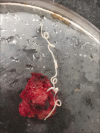Extralymphatic Filariasis
- PMID: 38283023
- PMCID: PMC10810389
- DOI: 10.4103/idoj.idoj_152_23
Extralymphatic Filariasis
Abstract
Filariasis caused by nematodes affects the structure and function of lymphatic vessels. Lymphedema due to lymphatic blockage and lymphadenitis is the usual mode of presentation of filariasis. However, rarely extralymphatic filariasis has been reported in uncommon sites, including skin and soft tissue. Wuchereria (W.) bancrofti is the most common nematode causing extralymphatic filariasis. We report a rare case of a 25-year-old man with live extralymphatic filarial infestation presenting as a facial subcutaneous soft-tissue swelling confirmed by ultrasonography (USG), which revealed the filarial dance sign. Filariasis can present in many different ways and pose a significant dilemma for the clinician. It is essential to be aware of atypical presentations of filariasis for prompt diagnosis and further treatment.
Keywords: Extralymphatic filariasis; filarial dance sign; subcutaneous filariasis.
Copyright: © 2023 Indian Dermatology Online Journal.
Conflict of interest statement
There are no conflicts of interest.
Figures
References
-
- Basavaraj K, Bharatesh SK, Murali D, Ramachandra K, Sowmya M. A study on morbidity management among lymphatic filariasis patients in Udupi district, Karnataka, India. Int J Med Public Health. 2017;7:92–6.
-
- Adhikari P, Upadhyaya P, Dhakal S, Dahal M, Bhattarai S. Filariasis presenting as an upper arm swelling – An unusual presentation. J Pathol Nep. 2018;8:1317–9.
-
- Mallick MG, Sengupta S, Bandyopadhyay A, Chakraborty J, Ray S, Guha D. Cytodiagnosis of filarial infections from an endemic area. Acta Cytol. 2007;51:843–9. - PubMed
-
- McGillan P. Development of small-molecule anti-wolbachia agents for the treatment of filariasis. The University of Liverpool (United Kingdom) 2017;17 Available at: https://livrepository.liverpool.ac.uk/3016953/
Publication types
LinkOut - more resources
Full Text Sources
Miscellaneous




